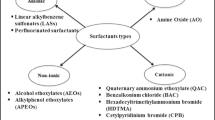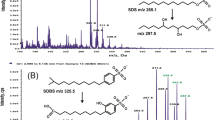Abstract
New stable silayl cationic surfactants have been studied for the destruction of toxic organophosphorus pesticides. Hexadecyl, dodecyl trimethyl silane ammonium chloride or iodide surfactants were synthesized and evaluated in the degradation of pesticides such as Diazinon, Malathion or Chlorpyrifos. The hydrolytic efficiency of each surfactant was tested by measuring the kinetics of model substrates cleavage under a pseudo-first order reaction. The iodo silayl based surfactants showed more destructive power than the chloro derivatives. Meanwhile, the hexadecyl moiety showed more effective pesticide degradation than the corresponding dodecyl moiety.







Similar content being viewed by others
References
Tonellato U (1979) In: Millal KL (ed) Solution chemistry of surfactants, vol 2. Plenum Press, New York, pp 541
Fornasier R, Milani D, Scrimin P, Tonettato U (1986) Functional micellar catalysis, Part 8, Catalysis of hydrolysis of p-nitrophenyl pinacolate by metal chelating micelles containing copper (II) or zinc (II). J Chem Soc Perkin Trans II:233
Feiters MC (1996) In: Reihoudt DN (ed) Comprehensive supermolecular chemistry, vol 10, Elsevier, Amsterdam, pp 311
Bunton CA, Ihara Y (1977) Micellar effects upon dephosphorylation and deacetylation by oximate ions. J Org Chem 42(17):2865
Hassan F, BEG AE (1996) A comparative study and behaviour of a series of cationic surfactants towards the degree of the basic hydrolysis of p-nitrophenylenyl acetate. Pak J Pharm Sci 9(1):1–10
Fendler JH, Findler EJ (1975) Catalysis in micellar and macromolecular systems. Academic, New York, pp 86–193
Cibulka R, Dovorak D, Hampl F, Liska F (1997) Metallomicellar hydrolysis catalysts containing ligand surfactants derived from alkyl pyridine-2-ylketoxime. Collect Czech Chem Comun 62:1342
Ahmed SM (2003) Detoxification of carbaryl pesticide waste water by micellar and metallomicellar solutions. Orient J Chem 19(3):519
Badawi AM, Yehia FZ, Amer AA (1996) Degradation of Malathion in water speeded by a cationic surfactants. In: 3rd Congress of Toxicology in Developing Countries, Cairo, Congress Proceeding 3, pp 297
Zakharova L, Ya L, Kudrgavtseva A, Shagidullina RA, Valeeva FG (2001) The factors determining the micellar effects on nucleophilic substitution reactions. J Mol Liq 94:79
Sowa F, Cranford J, Kenney EJ (952) Complex ammonium salts and processes for producing the same. US Patent 2580473
Blasko A, Bunton CA, Forounian JH (1993) Reaction of thiol and thione phosphorous (V) esters in nonmicellized amphiphiles. J colloid interface sci 163:500-506
Menger FM, Ladika M (1987) Origin of rate accelerations: the p-nitrophenyl ester syndrome. J Am Chem Soc 109:3145–3146
Epstein J, Kaminski JJ, Bolor N, Enever R, Sowa J, Thiguchi (1978) Micellar acceleration of organophospate hydrolysis by hydroximino–methylpyridinium type surfactants. J Org Chem 43
Torrents A, Stone AT (1994) oxide surface catalyzed hydrolysis of carboxylate esters and phosphorothioate esters. Soil Sci Soc Am J 58:738-745
Olah GA, LokHo T (1978) Silane/iodine-based cleavage of esters and ethers under neutral conditions. Proc Natl Acad sci 75:4-6
Kotoucova H, Cibulka R, Hampi F, Liska (2001) Amphiphilic quaternary pyridinium ketoxime as functional hydrolytic micellar catalysts-does the nucleophilic function position influence their reactivity. J Mol Catal A Chem 174:59
Author information
Authors and Affiliations
Corresponding author
About this article
Cite this article
Badawi, A.M., Ahmed, S.M. Degradation of Pesticides Wastewater by Silyl Based Cationic Surfactants. J Surfact Deterg 10, 103–108 (2007). https://doi.org/10.1007/s11743-007-1019-5
Received:
Accepted:
Published:
Issue Date:
DOI: https://doi.org/10.1007/s11743-007-1019-5




